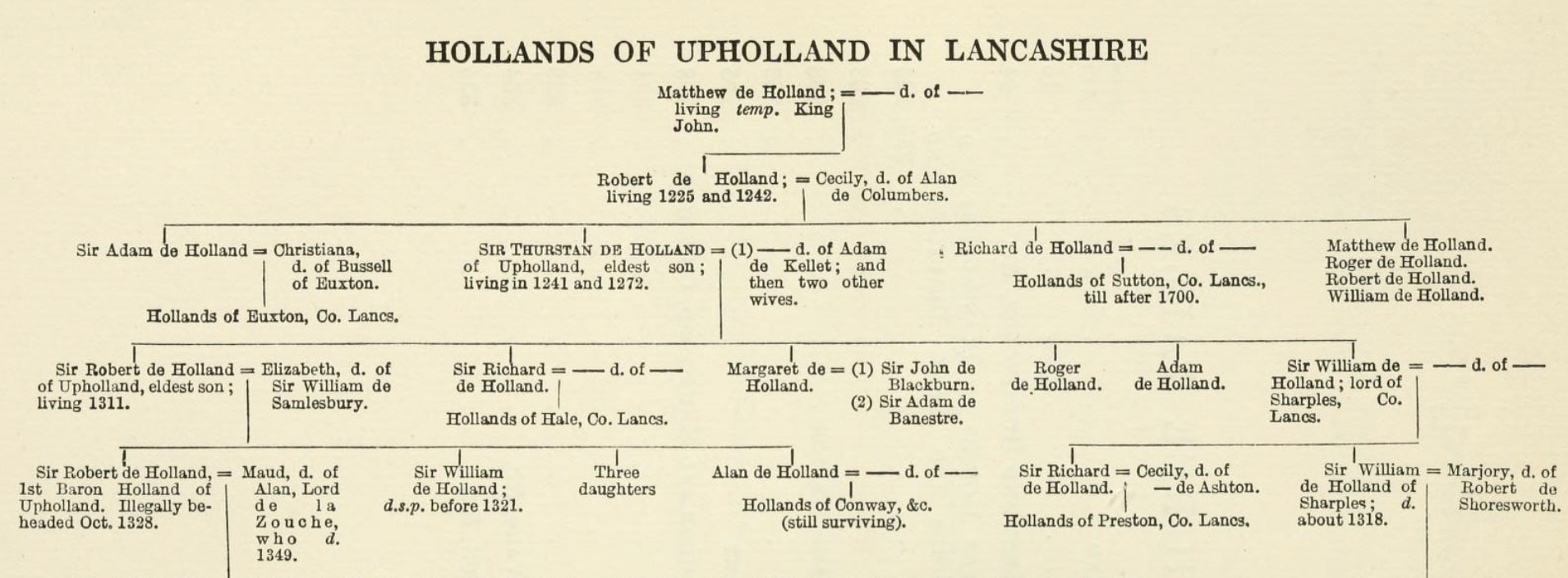4. Holland of St Athan, Walywyn's Castle, Conway Castle and Lancashire
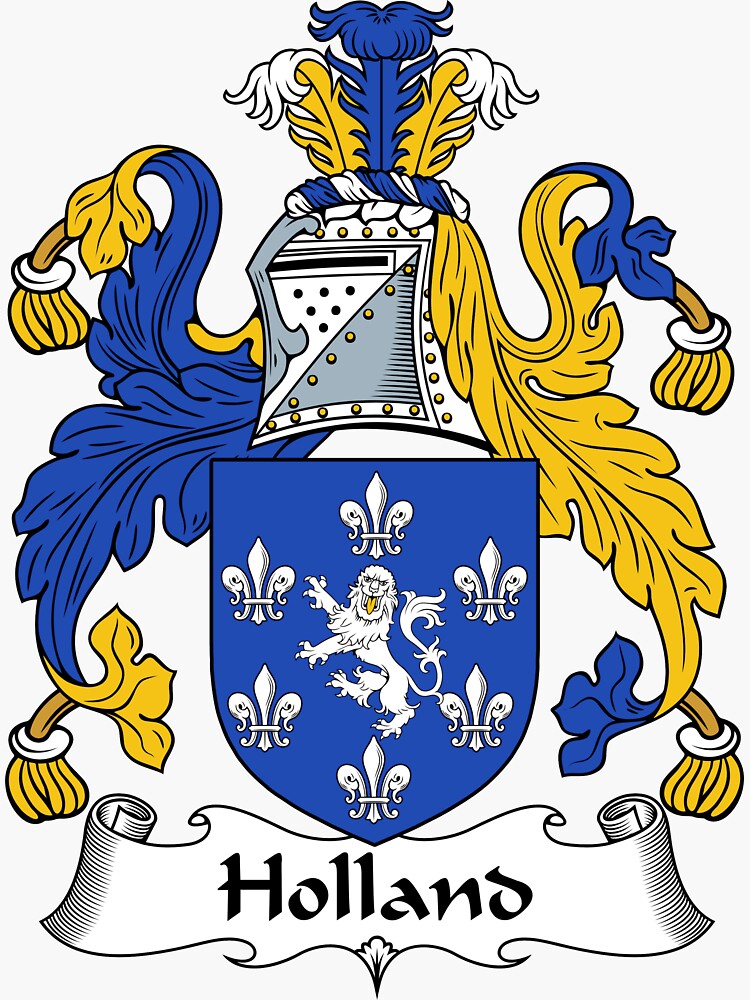
The lineage of the Holland family can be readily traced right back to the 1300's, and back even further, as they are well documented. A recent family line is shown here, with John and Rice Holland involved as shipwrights (and smugglers) at Aberthaw port. They came originally from Walwyn's Castle, Pembrokeshire, and before that the family owned Conway (or Conwy) Castle (in present day Caernarfonshire). The link to the other families is that Alice Holland, the daughter of John and Elizabeth Holland, married Christopher Bassett - who's daughter Margaret in turn married Edward Williams. Also Thomas and Cecil Andrews are the great grandparents of both Margaret and Edward Williams.
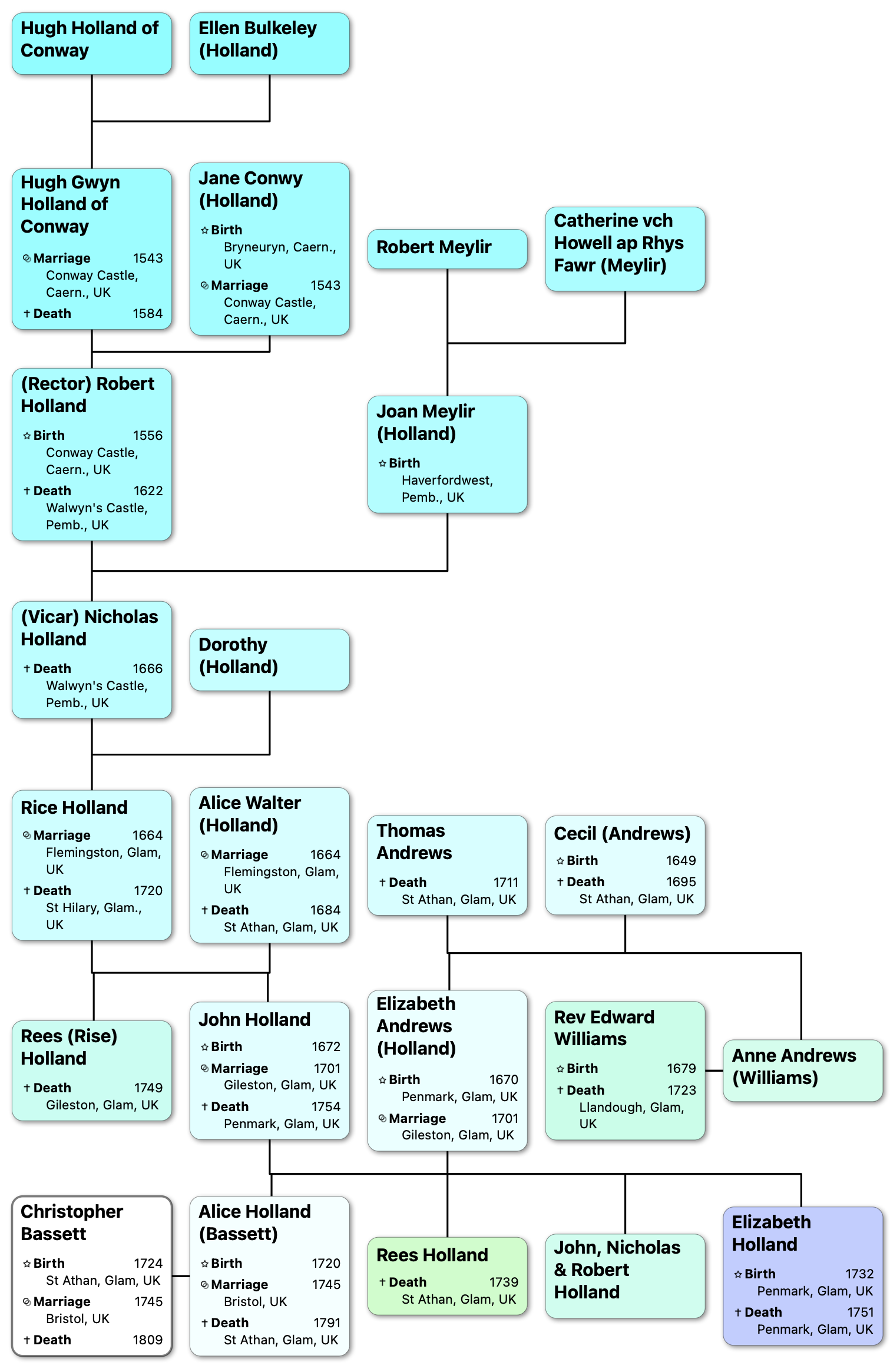
The early Holland family tree shows that, prior to gaining the lands and rights of Conway Castle, they came from Upholland in Lancashire. In the 1300's, it was Sir Robert De Holland who became the most famous of the Hollands, as he successfully climbed into high society but then took part in a failed insurrection against King Edward II - after which he was illegally beheaded for treachery by his own side. Notwithstanding this, his son went on to marry Joan Plantagenet (grandaughter of King Edward I) and his two grandsons became half brothers to King Richard II.
Hugh Gwyn Holland (1543-1584) and Jane Conway (of Brynevryn)
Hugh Gwyn Holland was born to Hugh Holland and Ellen Bulkeley (who was daughter and heir of Jenkin Bulkeley, son of Sir Richard Bulkeley).
Jane was daughter of Hugh Conway of Bryneurin and Ellen, daughter of Sir W. Griffiths of Penrhyn.
1543 Hugh Gwyn Holland married Jane Conway of Brynevryn at Conway Castle, Caernarvonshire.
Hugh Gwyn Holland owned Conway Castle and much of Conway town, including a town house called "Plas-Issa". He also owned the ferry across the Conway river [ref: 304].
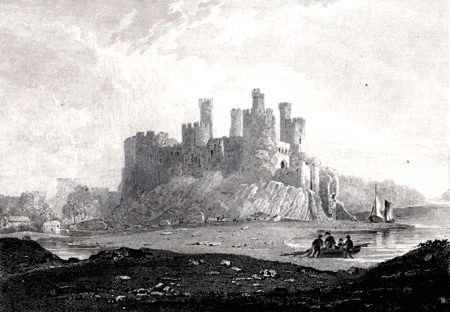
Hugh Holland died 1584 and is buried in Conway Church where there is a monument to him by his son Edward. Further inscriptions successively added 3 more generations of the family.
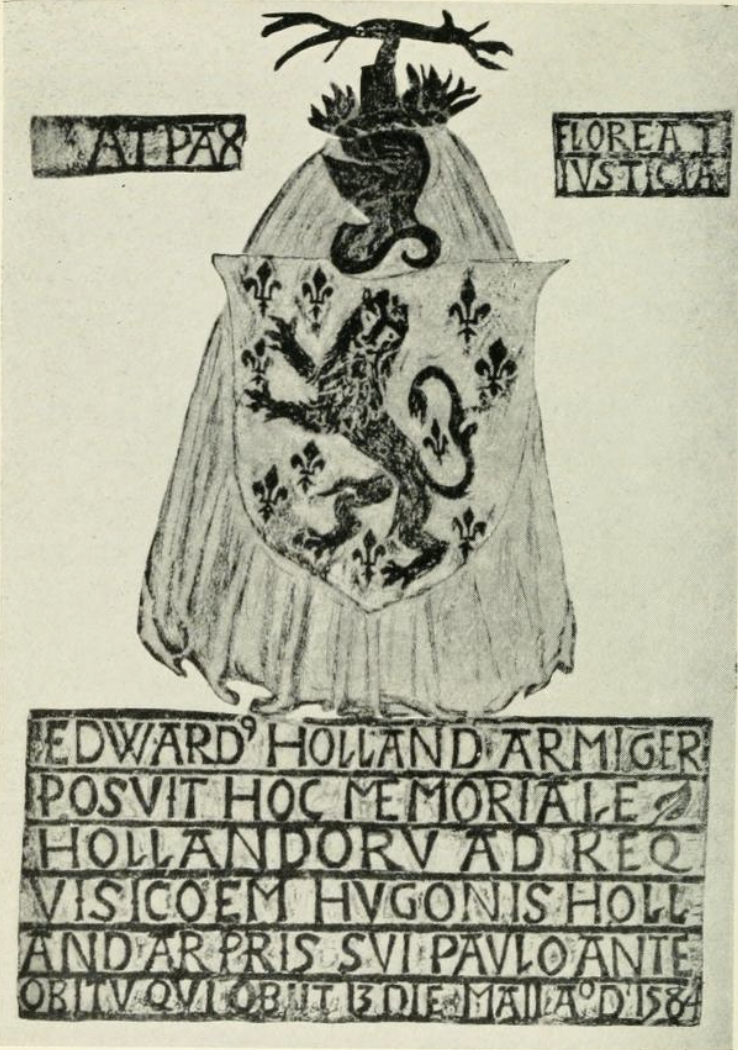
Children of Hugh Gwyn and Jane Holland:
- Edward Holland of Conway (d.1601)
- William Holland
- Robert Holland (see Robert and Joan Holland)
- Harry Holland
- Hugh Holland
- Simon Holland
- Jane who married Hugh Stodart of Conway
Robert (1556-1622) and Joan (Meylir) Holland
Robert was born at Conway Castle 1556/7, third son of Hugh Gwyn Holland. He studied at Clare College, Cambridge 1577, graduated from Magdalene in 1578, and gained an M.A. from Jesus in 1581. [His details are provided in the Dictionary of Welsh Biography - ref: 001]
Joan was the daughter of Robert Meylir of Haverfordwest and Catherine (heiress of Howell ap Rees Vawr of Cardiganshire).
Robert Holland was a strongly Protestant clergyman, in 1580/1 he was ordained deacon (on a title from his father) at Bangor; he became a priest at Ely in 1580, and was a licensed curate of Weston Colville. He was also schoolmaster at Dullingham, near Newmarket. Records suggest he was a parson of Llanddowror as well as holding positions at Prendergast (1591), Walwyn's Castle 1607/8, and Robeston West in 1612.
Robert Holland moved to Pembrokeshire in 1591. There he married Joan Meylir of Haverfordwest, and founded the Holland family of Walwyn's Castle.
Robert Holland published at least six books:
- (1) The Holie Historie of our Lord (etc.), 1592, a metrical paraphrase of the Gospel narrative;
- (2) Dau Gymro yn taring yn bell o'u gwlad, a dialogue against soothsayers and conjurers, dated c. 1595.
- (3) a translation of the Exposition of the Lord's Prayer by William Perkins, 1599.
- (4) a book called Darmerth, neu Arlwy i Weddi, published at Oxford in 1600.
- (5) a translation of Perkins's catechism The Foundation of Xtian Religion.
- (6) Basilikon Doron, 1604, a translation of King James's work.
Robert Holland appears to have died in 1622 [ref: 304].
Robert and Joan Holland had 6 children including:
- Nicholas Holland (see Nicholas Holland)
Nicholas Holland (d.1666)
Nicholas Holland was born to Robert and Joan Holland, who were living at Walywyn's Castle, Pembrokeshire.
1618 appointed as vicar of Marloes parish, Pembrokeshire.
Nicholas, and his son, practiced law at Haverfordwest and held estates at Walwyn Castle, Walton West and others across Pembrokeshire.
Nicholas Holland died 1666.
Children of Nicholas Holland:
- Nicholas Holland of Walywyn's Castle and Haverfordwest, Married Dorothy Laugharne plus three other wives. Died 1718.
- Rice Holland (see Rice and Alice Holland)
Thomas (-1711) and Cecil (1649-1695) Andrews
Thomas is described as a mariner and navigator.
1670 Hearth tax returns for Gileston shows Thomas Andrews having 6 hearths - a well established house.
1695 Burial of Cecil (aka Cissel) Andrews at St Tathan, St Athan, wife of Thomas Andrews. There is a Memorial Description that says she died age 46.
1709/1710 Deed shows that Thomas Andrews , and his late wife Cissill (deceased) had a daughter Anne married to Edward Williams of Llandough-juxta-Cowbridge. They also had an eldest daughter, Elizabeth who was married to John Holland. The deed itself shows that one Oliver Richard had already purchased 1/3 of Greendowne farm from John and Elizabeth Holland and Thomas Andrews [ref: 302].
1711 A will for Thomas Andrews [ref: 002] states:
- his wish to be buried in St Athan
- to daughter Elizabeth, my silver drinking cup
- to Little Samuell, the little cottage at East Aberthaw and the rose garden and orchard, and part of £20 pounds that is in John Holland's hands by bonds.
- "I appoint my daughter Anne to be my executrix" (Anne Andrews, who became Anne Williams, is identified on the cover of the Will).
Children of Thomas and Cissel Andrews:
- Elizabeth Andrews (see John & Elizabeth Holland).
- Ann Andrews married Edward Williams of Llandough-juxta-Cowbridge, a church clerk (see Rev. Edward William & Anne Andrews (William) in Section 2)
- Samuell (as identified in the Will)
Rice and Alice (-1684) Holland
Rice Holland (aka Rhys) born to Nicholas Holland at Walwyn's Castle, Pembrokeshire.
Alice was Alice Walter of St Athan.
Rice moved from Walwyn's Castle to Aberthaw port where he worked as a ship carpenter, living nearby in Flemingstone [ref: 301]. He married Alice Walter in 1663 at St Athan.
Alice died 1684 and is buried at St Athan.
Rice Holland died 1720 and is buried at St Hilary.
Children of Rice Holland:
With wife no.1 Alice:
- John Holland b. 1672 (see John & Elizabeth Holland)
- Rees (aka Rise) Holland. A shipwright who died at Gileston, 1749 and left a will [ref: 002].
With wife no. 2 Catherine - a total of 9 children including:
- William who inherited 20.5 acres
- Nicholas who inherited 3 acres in St. Athan
John (1672-1754) and Elizabeth (b.1670) Holland
John Holland born c.1672 was the son of Rice Holland and Alice Walter of St Athan, Glamorganshire. He was a shipwright, ship-master and Merchant working from Aberthaw port [ref: 301]. Indications are that he was also involved in smuggling.
Elizabeth was born Elizabeth Andrews in 1670, the daughter of Thomas Andrews (a mariner from Penmark) & Cissel Andrews.
1701 Marriage register for John Holland and Elizabeth Andrews at Gileston, St Giles church.
They appear to continue to live in the Gileston/ St Athan parish area, which at the time was close to Aberthaw port and its associated sea trade, particularly with Bristol and Minehead.
1709/10 Deed of covenant for £118 for land in Bonvilston. Recites that Oliver Richard has purchased a third of Greendowne farm from John Holland and wife Elizabeth (who is the eldest daughter of Thomas Andrews) [ref: 302].
1721 Aberthaw sailings to Minehead (Mynehead) and Bristol (Bristoll) mentioning John Holland as Ship Master and Merchant [ref: 309]. For each date there is the Name of Ship, Master, Merchant and Cargo:
- Jan. 11 - Blessing of Aberthaw - John Holland -(?)-11 packs stockins; 10 stone cheese; 1 small piece raw cloath, 1 wallet gloves containing ten doz.
- Apr. 5 - Elizabeth of Aberthaw - John Holland -David Williams-10 packs 3 fardles stokins 10 firkins butter --- woollen cloathe & Durois [note: a coarse woollen fabric]
- Apr. 20 - Elizabeth of Aberthaw - John Holland -Margret Mathew-3 packs (5), firkins butter
- Apr. 25 - Elizabeth of Aberthaw - John Holland -William David-12 doz. calves skins, 20 raw hides, 2 fardles stokins
- Apr. 26 - Elizabeth of Aberthaw - John Holland-Ed Bowen-6 baggs wooll qt. 1,928 lbs.
- May 4 - Betty of Aberthaw - John Holland -Margrett Mathew-7 packs 3 fardles stokins
- May 11 - Elizabeth of Aberthaw - John Holland -John Holland-3 packs 2 fardles stokins
- May 25 - Blessing of Aberthaw - John Holland -John Holland-1 pack stokins; 4 doz. Calves skins, 5 hides 2 kipps
- June 8 - Elizabeth of Aberthaw - John Holland -John Holland-3 packs and 1fardle stockins (?)Wallet gloves containing 6 doz.
- July 7 - Elizabeth of Aberthaw -John Holland -John Holland-3 packs & fardles stockins, 8 potts and stands butter
- July 28 - Elizabeth of Aberthaw - John Holland -John Ellis-9 baggs wooll qt. 3,095 lb.
1732 Baptism register for daughter Elizabeth Holland to John and Elizabeth Holland at Penmark.
1747 John Holland received his cousin William Holland, who lived in London and who sold his house painting business to become a Moravian Minister [ref: 301].
1751 Will of daughter Elizabeth Holland (age 19) gives sums to her brothers, John, Robert and Nicholas Holland as well as her nieces Elizabeth and Margaret Bassett. Also mentions her nephew and niece, Thomas and Elizabeth Holland, and their father Rees Holland, deceased [ref: 002]. There is an associated burial register for Elizabeth Holland at Penmark/ St Athan in 1751.
1754 Will of John Holland - occupation shipwright - states 'Alice Bassett (wife of Christopher Bassett) daughter and sole executrix in this will'. It also mentions '.. and sixty pounds lying in my in-law Christopher Bassetts hands..." and '.. all the rest of my goods, chattels and personal estates whatsoever I give and bequeath unto my daughter Alice.." [ref: 002]. There is a burial record for a John Holland at Penmark/ St Athan in 1753. The Will apportions his estate as follows:
- John Holland (son) receives all land in Penmark, including "Marsh House" plus leased land from Robert Jones Esq. and one furnace.
- Nicholas Holland (son) to receive "Fishers Bridge" in Lantwit Major/ Eglwys Brewis (purchased from Evan Leys Esq.)
- Robert Holland (son) to receive land in St Athan.
March House Farm was the long time family home of the Holland family of East Aberthaw [ref: 301]. This was a brick structure resembling the stone built Plantation period "bawns" found in Ireland [fortified farmhouses with a perimeter wall]. It was erected by Thomas Spencer in the 1630's - a merchant trading from Aberthaw with the West Indies and who had a tobacco plantation on St Kitts. The farmhouse comprised a loopholed wall 0.6m thick and 2.3m high surrounded a court 30m long by 19m wide. Once a large county house it was fortified for use as a store for tobacco illegally imported into Wales. The surviving remains of the house were levelled for safety reasons prior to their being covered by an ash tip for the power station [ref: 303].
- A deed in 1718 refers to the sale of 30 acres of land in Penmark to John Holland by Arthur Spencer and Margarett Spencer (widow)(presumably relatives of Thomas Spencer, d. 1682) [ref: 306, 307].
The picture below shows the remains of March House farm (since demolished) with Aberthaw cement and lime works in the background.
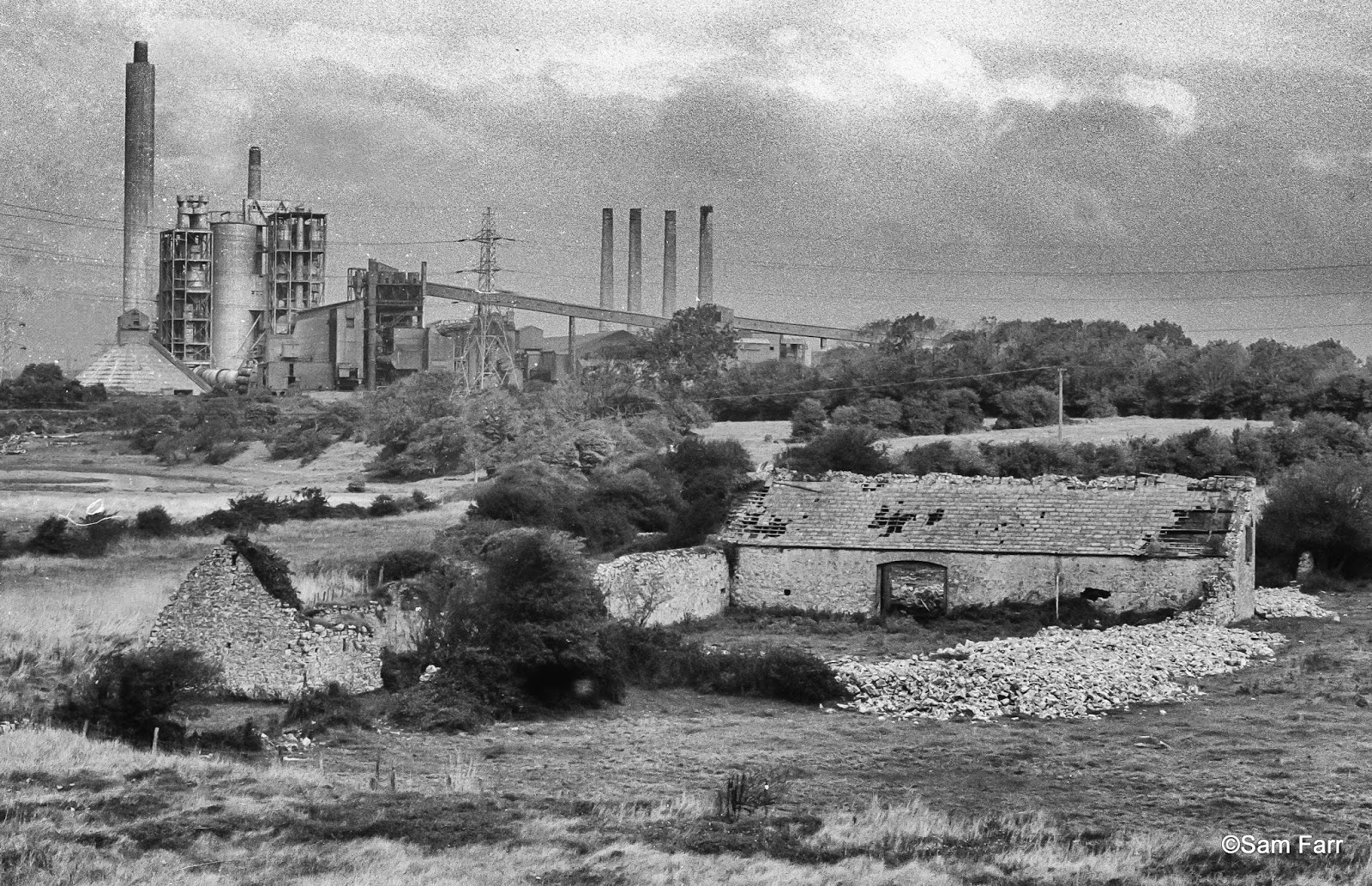
Children of John and Elizabeth Holland:
- Rees Holland became a mariner and married Mary Sweet, daughter of Arthur Sweet (also a mariner, who was master of the bark "Blessing of Aberthaw" in 1675 [ref: 301]). Rees and Mary had children Thomas and Elizabeth. Rees died 1739 in St Athan.
- John Holland who had a son, also John Holland.
- Nicholas Holland (-1794)
- Robert Holland who had sons Thomas and John
- Alice Holland (1720-1791) - see Christopher and Alice Bassett
- Elizabeth Holland (1732-1751)
Early Holland Families
Conway Castle was built 1283-1287 by Edward I after his conquest of the Welsh Chieftans - he brought into Wales English settlers and garrisons for his castles. This is how the Holland family came to own Conway Castle, they originally came from Upholland, Lancashire. The tree chart below shows the Holland family at Conway Castle and the links to Holland families at Upholland, Lancashire and to the Plantagenet Kings [ref: 305, 001].
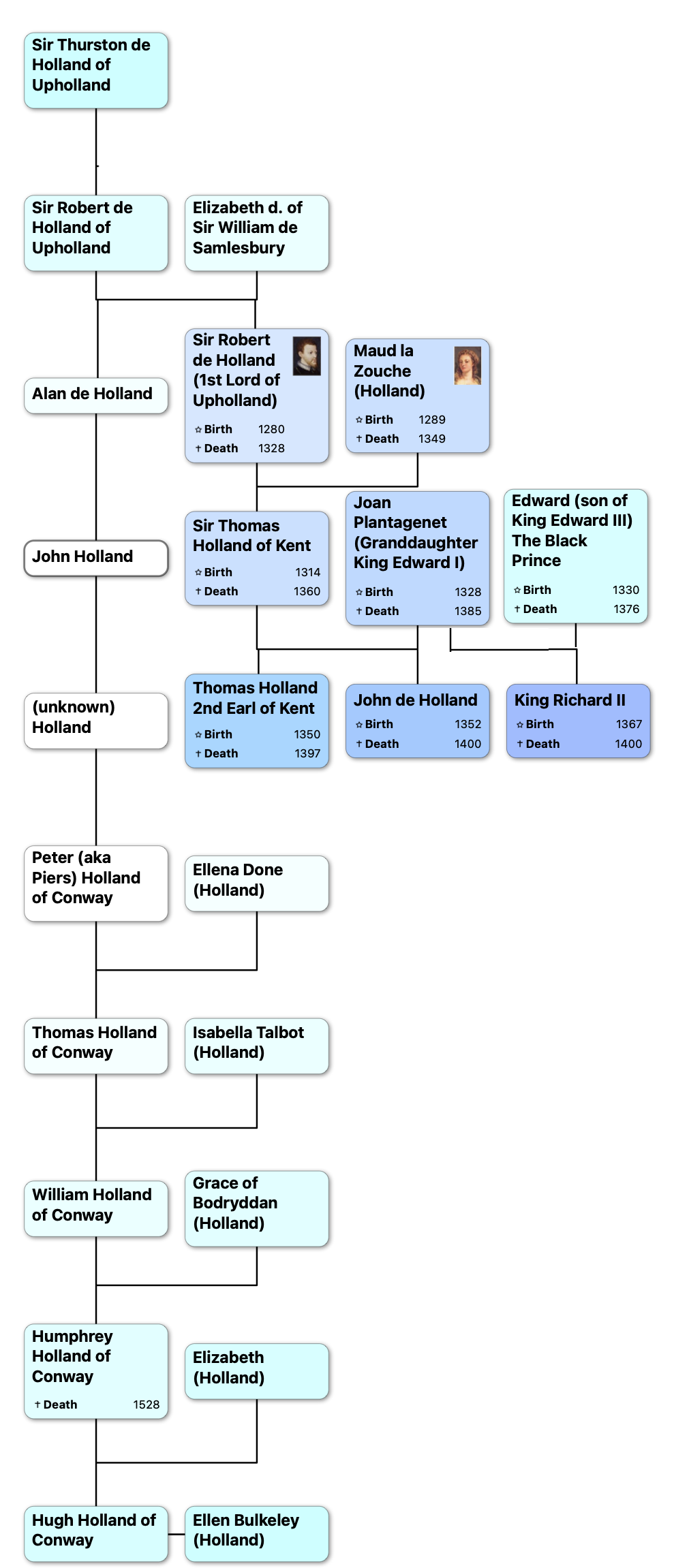
Key Holland family members from this earlier period are :
Peter (aka Piers) Holland of Conway, served in the household of King Henry IV (1367-1413) - and owned Conway Castle and much of the town and adjacent lands.
The Holland family at Conway are said to descend through Alan Holland of Upholland, Lancashire who was therefore presumably given the position and rights of Conway Castle and associated lands [ref: 308, 305]. However it is likely that this was supported by his brother, Sir Robert de Holland, who held significant influence, and who came to own a number of English and Welsh castles of his own.
It was Robert Holland, brother of Alan Holland, who led the Holland family into higher levels of society - he become the first Lord Holland of Upholland [ref: 305]. It was he who:
- Starting out as a Lancashire squire, advanced his position as chief agent and adviser to his feudal Lord, Thomas Earl of Lancaster - and so given lands in Cheshire, Staffordshire, Yorkshire and Buckinghamshire.
- Took part in the Scottish Wars during the reigns of Edward I and Edward II - receiving land in Derbyshire and other territorial grants from the crown.
- In 1307 he obtained leave to fortify his mansions in Lancashire and Leicestershire, and became in charge of the Royal Castles of Chester, Rhudlaw and Flint.
- He married (in 1308) Maud, daughter of Lord Alan of Ashby de la Zouche by whom he inherited lands in Northamptonshire, Oxfordshire and Hertfordshire.
- He helped repel a local rebellion led by the Banastre family against the Earl of Lancaster, who were defeated in a battle near Preston in 1315 (see Banastre Rebellion - Wikipedia) and the leaders beheaded (one personally by Sir William de Holland, Robert's brother)
- He was summoned to parliament in 1314 and 1321 as Baron Holland.
- In 1322, together with his brothers, he joined up with Thomas, Earl of Lancaster in an insurrection against Edward II, the King - but they were defeated by the King's forces in the Battle of Boroughbridge (aka the Despenser War). The Earl of Lancaster was beheaded. Robert Holland surrendered to the king, and was sent to prisons at Dover and York, with all his territories confiscated by the crown.
- In 1328 the new king Edward III directed that the estates should be restored back to their original owners.
- However, by then Henry, Earl of Lancaster, (son and heir of Lord Thomas, Earl of Lancaster) considered that Robert Holland has been involved in treachery against the Lancaster cause and had him illegally beheaded in 1328 - Henry received the head himself.
- Robert Holland's son, Sir Thomas Holland of Kent, secretly married Joan Plantagenet (granddaughter of King Edward I, aka "the Fair Maid of Kent" when she was just 12 years old). When Sir Thomas Holland was away fighting in Prussia, Joan was abducted and forced to marry William Montacute - heir to the Earl of Salisbury (they were both 13) - and it took a decree of annullment from Pope Clement VI in Rome to get her returned to Robert Holland. Robert and Joan had two sons, and Robert ultimately inherited her lands and became Earl of Kent in right of his wife. After his death she went on to marry her second husband The Black Prince (son of King Edward III and her cousin) - they had a child who became King Richard II.
- Robert Holland's grandsons (by Joan Plantagenet) were Thomas Holland (1350-1397), 2nd Earl of Kent and John de Holland (1352-1400), Earl of Huntingdon and Duke of Exeter. They were half brothers to King Richard II and key members of his court - their armies fought with the King's against the French and Scots. In 1384 they were both made Knights of the Garter.
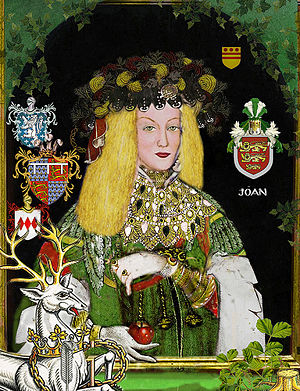
King Richard II (1367-1400) became King in 1377 succeeding his grandfather Edward III. At this time a 'poll tax' had been introduced, to pay for the 100 years war with France, which led to the peasants revolt in 1381. During his reign his court had many factions and feuds, particularly with the 'Lords Appellant' - the Duke of Gloucester and various Earls. He exiled his cousin Henry Bolingbroke, but while Richard II was away in Ireland, Bolingbroke returned from exile and with the Earl of Northumberland gained support enough such that Richard surrendered on his return in 1399. The next year, 1400, Richard was secretly killed. Henry Bolingbroke became King Henry IV.
Details of the even earlier Holland family tree - dating back to the 1200's, are shown below [ref: 305]:
